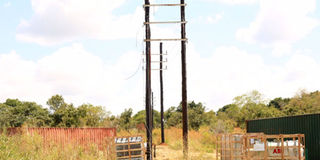ERA cuts transmission costs by more than half

Power line. A 33kV double circuit D-Line under construction from Acwa to Layibi Substation in Gulu District. FILE PHOTO
What you need to know:
- Costs. For 2020 to 2022, UETCL which had applied for Shs216b for its costs will instead be allowed to recover only Shs105b in 2020, and Shs65b in 2021 yet it had applied for Shs204.8b.
The Electricity Regulatory Authority (ERA) has slashed Uganda Electricity Transmission Company Limited’s (UETCL) capital, operation and maintenance costs by more than half for the period 2020-2022.
Documents seen by Daily Monitor indicate that ERA has approved less than half the money requested for by the power transmission company for its capital, operation and maintenance costs for the multi year tariff period.
“... the Authority considered the application by UETCL and resolved as follows; Transmission energy loss trajectory for the multi-year tariff period of 3.35 per cent in 2020, 3.29 per cent in 2021 and 3.03 per cent in 2022,” the November 12, 2019 letter from the regulator, reads in part.
This is higher than the loss targets set earlier at 3.38 per cent in 2017, 3.37 per cent for 2018 and 3.38 per cent for 2019.
UETCL transitioned from a single year tariff regime to a multi year tariff regime which took effect between 2014 and 2016.
This requires UETCL to apply to the electricity regulator which approves tariff performance parameters for the next review period which is always after three years.
For 2020 to 2022, UETCL which had applied for Shs216b for its costs will instead be allowed to recover only Shs105b in 2020, and Shs65b in 2021 yet it had applied for Shs204.8b.
In addition, the power transmitter will only be permitted to recover Shs75b in 2022 instead of the Shs172b it had applied for.
It is said that increased maintenance costs improve network reliability but place a heavy burden on consumers since the costs are recovered through the tariff.
Capex severely cut
The biggest deduction went towards the company’s planned capex which was trimmed to Shs60.4b from Shs126b for 2020.
For the grid, UETCL applied for money for upgrading substations such as Nkenda, SCADA software for the substations, constructing evacuation lines and undertaking feasibility studies.
While $2.3m was approved for a power transformer at Nkenda substation in order to ensure reliable evacuation of power from the mini hydros, the feasibility studies were rejected.
“In the recent past, UETCL has received an influx of possible investors seeking to finance the projects from private funding. The challenge is the lack of completed feasibility study documents,” the ERA report reads in part.
However, the Authority rejected the application on grounds that UETCL did not clearly breakdown the costs and role that it would play in the study as it intends to hire a consultancy to undertake them (studies).
In addition, the regulator noted that UETCL had been slow in implementation of its capex plan.
For instance, in 2018, it was noted that UETCL took an average of one year to complete a normal project procurement and more than 3 years in worst cases.
For its non grid expenses, UETCL applied for Shs74b across the three year period for construction of a head office building to accommodate staff residents in different offices in Kampala into one office in a bid to reduce rent. The cost was approved.
Repair costs reduced
Maintenance costs: The regulator also severely reduced the repairs and maintenance costs which are mainly driven by the number of substations and growth in transmission lines.
During the period, UETCL expects to grow the network length from 2890km to 5721km, increase from 21 to 50 substations and 97 transformers among others.
However, the regulator approved substation maintenance costs on the assumption of growth by an average of three substations per year at a growth rate of Shs90m per substation.




